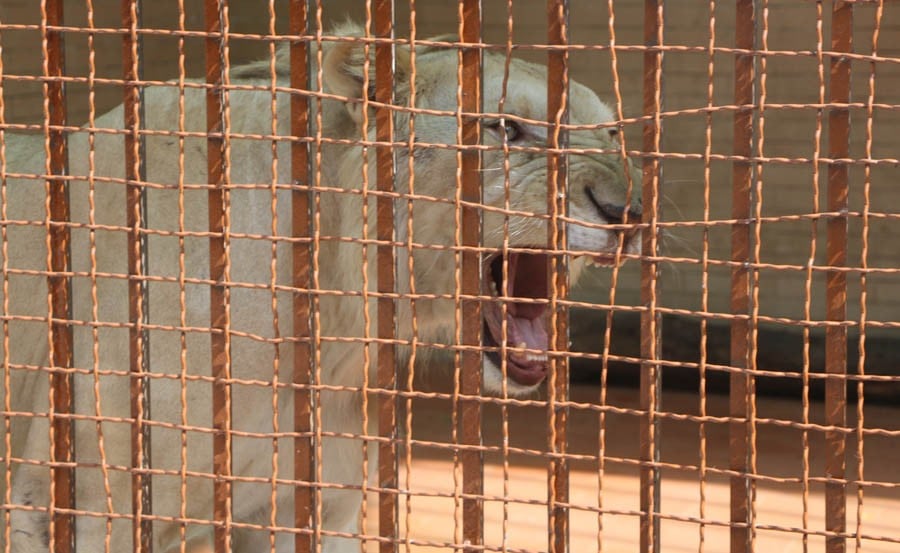
18 tigers and lions worth Rs. 100 million have been gifted to Pakistan by the UAE. What is behind this generosity?

A panting big cat - part of a new batch of lions that have recently arrived from the UAE - sits in the shade at the Lahore Zoo and watches the few visitors allowed to see it. He is one of the 18 tigers and lions that were recently gifted to Pakistan by the UAE Prime Minister Sheikh Mohammed bin Rashid Al Makhtoum. These new arrivals have been shifted from a wildlife conservation centre in the UAE and remain separated from other big cats in the zoo till they get acclimatized to their new surroundings.
The Chief Minister of Punjab Usman Buzdarvisited the Lahore Zoo towelcomethe ten tigers and eight lions aged between 1-5 years, four of which are white tigers, six Bengal tigers and eight African lions, estimated at a total ofRs100million.
In a Press Statement the Ministry of Climate Change Pakistan said"The Al Nakhi Wildlife Centre in Dubai was in possession of more than 400 big cats, sothe Lahore Zoo requested the UAE Premier to donate a few to Pakistan."
But what was the need for Lahore Zoo to receive more big cats when it already has 16 lions, 4 tigers and 4 leopards?
According to the Adviser to Pakistan’s Minister for Climate Change, Malik Amin Aslam, "Inbreeding is a major issue in big cats in Punjab. These animals have been breeding with their offspring for years. Thedeleterious effects of inbreeding arestill-births, genetic disorders and low immunity." This implies that bringing in tigers from outside would improve the health of future tigers and lions born in Lahore.
A media representative of the UAE Embassy speaking to TNS said,"UAE has made great efforts in wildlife conservation and we give animals and birds to Pakistan on a regular basis. Yearly, the Abu Dhabi government releases a number ofHoubara bustard,deer and falcons in Pakistan for breeding and conversation."
What he doesn’t mention, however, is that the UAE royal families regularly use Pakistan as one of their favourite hunting grounds, particularly for Houbara bustards and markhors, and that the gifting of tigers and lions worth Rs. 100 million could be used to curry favour for other hunting pursuits. Pakistan’s courts as well as foreign and interior ministries have occasionally placed bans on hunting that have subsequently been lifted for members of UAE’s royal family. Local hunters never get similar permits. Gift-giving and investment in infrastructure in areas of Pakistan where houbara bustard and markhor hunting takes place are some of the ways in which the UAE royalty is able to retain a foothold in areas otherwise prohibited to hunters.
According to animal rights activists,breeding in captivity is not a very healthy practice as it eventually leads to genetic disorders and other complications in animals. Talking to TNS, Hassan Ali, Director Lahore Zoo says,"Weather in the UAE is quite harsh as it’s hot and humid environment does not go well withanimals. Lahore is comparatively a better place for them."
When the announcement was made that UAE was gifting lions and tigers to Pakistan, several people raised concerns about their life and wellbeing as a number of animals have died in zoos across Pakistan. To this the director says, "Mortality and birth is a phenomenon that goes hand in hand. After a certain age animals start dying and new animals take their place. At times we have surplus animals too. Animals in cages live longer as compared to tigers or lions in the wild where they have to fight to survive."
Sam Sattar an Animal Rights activist from Karachi disagrees with this, "Keeping animals in cages is not only wrong but against the nature of these big cats; they need sanctuaries where they can move about freely, have space to run and play. None of the zoos in Pakistan are of international standards and the conditions are generally so pathetic that they should be closed down as people don’t know how to keep these precious animals. They are confined to four walls and cages where air circulation is limited, putting them in danger of a heatstroke, particularly in this weather."
The Lahore Zoo’s Director Hassan Ali adds, "Outside animals need to be introduced so new and healthy species are added to the inventory.The Lahore Zoo has improved its conditions over the years, however many things still need attention."One of the things that needs attention, perhaps, is the zoo’s website that hasn’t been updated since 2016.
Last week a picture of these tigers and lions started circulating on social media showing the big cats lying on the floor sedated, which led to concerns raised overanimal cruelty. Dr Abid Hussain of Asim Pet Clinic Lahore, who treats these animals, opined that big cats cannot be controlled without sedation. They are such powerful animals that if you try to get a hold of them without sedation they not only harm humans but themselves too. As for side effects, he says there is only a 2% chance of that.
The debate about conservation, display trade, gifting of animals of various genre and species is not likely to end soon, however what is certain is that these animals need to be treated well and big animals like the ones that have just arrived need adequate room to feel like they are in their natural habitat. At the moment, the Lahore Zoo doesn’t have quite the space for that.